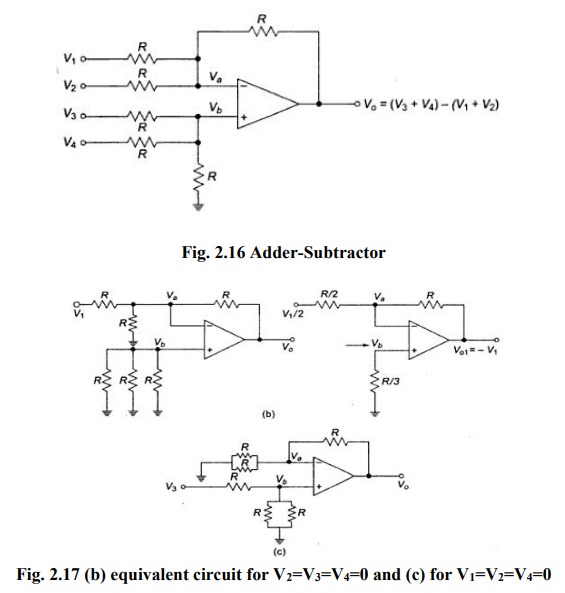Applications of Operational Amplifier - Subtractor using Operational Amplifier | Linear Integrated Circuits : Applications of Operational Amplifier
Chapter: Linear Integrated Circuits : Applications of Operational Amplifier
Subtractor using Operational Amplifier
Subtractor:

A
basic differential amplifier can be used as a subtractor as shown in the above
figure. If all resistors are equal in value, then the output voltage can be
derived by using superposition principle.
To
find the output V01 due to V1
alone, make V2 = 0.
Then
the circuit of figure as shown in the above becomes a non-inverting amplifier
having input voltage V1/2 at
the non-inverting input terminal and the output becomes
V01
= V1/2(1+R/R) = V1 when all resistances are R in
the circuit.
Similarly
the output V02 due to V2 alone (with V1 grounded) can be written simply
for an inverting amplifier as
V02
= -V2
Thus
the output voltage Vo due to both the inputs can be written as
V0
=V01 - V02 = V1 - V2
Adder/Subtractor:

It
is possible to perform addition and subtraction simultaneously with a single
op-amp using the circuit shown in figure 2.16.
The
output voltage Vo can be obtained by using superposition theorem. To find
output voltage V01 due to V1
alone, make all other input voltages V2, V3 and V4
equal to zero.
The
simplified circuit is shown in figure 2.17. This is the circuit of an inverting
amplifier and its output voltage is, V01= -R/(R/2) * V1/2=
- V1 by Thevenin‘s equivalent
circuit at inverting input terminal).
Similarly,
the output voltage V02 due to V2 alone is,
V02=
- V2
Now,
the output voltage V03 due to the input voltage signal V3
alone applied at the (+) input terminal can be found by setting V1, V2 and V4
equal to zero.
V03=V3
The
circuit now becomes a non-inverting amplifier as shown in fig.(c).
So,
the output voltage V03 due to V3 alone is
V03
= V3
Similarly,
it can be shown that the output voltage V04 due to V4
alone is
V04 = V4
Thus,
the output voltage Vo due to all four input voltages is given by
Vo
= V01 =
V02 = V03 = V04
Vo = - V1 -V2
+V3+ V4
Vo = (V3
+V4) – (V1 +V2)
So,
the circuit is an adder-subtractor.
Related Topics